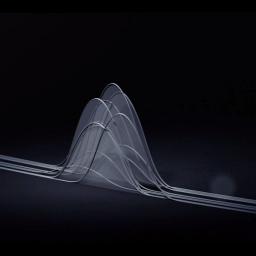
Emily Oster
covers an old topic that's still controversial:
Many medical studies show positive health effects from higher vitamin levels. The only problem? These studies often can't tease out the effect of the vitamins from the effect of other factors, such as generally healthy living. Studies that attempt to do this typically show no impact from vitamin use - or only a very tiny one on a small subset of people. The truth is that for most people, vitamin supplementation is simply a waste of time.
[Author note: The article avoids what I'd consider the main question: since these studies are not exactly new, why does my doctor still recommend a multivitamin every time I visit? And what other things does our society universally accept that might be pointless?]
Recent scientific inquiry shows that the mighty Tyrannosaurus may have been inclined to hunt in packs, rather than going it alone. Adjacent track ways of tyrannosaurus footprints have been discovered (
full text) that suggest that tyrannosaurids hunted in packs. The fossilised footprints show clear evidence that the animals
travelled together, with all three tracks going in the same direction around the same time, suggesting that these dinosaurs may have been social, and not solitary, animals.
The skeletal record of tyrannosaurids is well-documented, whereas their footprint record is surprisingly sparse. There are only a few isolated footprints attributed to tyrannosaurids and, hitherto, no reported trackways. We report the world's first trackways attributable to tyrannosaurids, and describe a new ichnotaxon attributable to tyrannosaurids. These trackways are from the Upper Cretaceous (Campanian - Maastrichtian) of northeastern British Columbia, Canada. One trackway consists of three tridactyl footprints, and two adjacent trackways consist of two footprints each. All three trackways show animals bearing southeast within an 8.5 meter-wide corridor. Similarities in depth and preservation of the tyrannosaurid tracks indicate that these three trackways were made by track-makers walking concurrently in the same direction. These trackways add significantly to previous osteology-based hypotheses of locomotion and behavior in Tyrannosauridae by providing ichnologic support for gregariousness in tyrannosaurids, and the first record of the walking gait of tyrannosaurids.
The downing of Malaysia Airline MH17 in the Ukraine is turning out to be one of the biggest of tragedies of 2014 and we don't have all the answers yet.
Here is a look at some of the technologies being used to unravel the mystery. From infrared to satellite imagery to chemical signatures, it's all being used to get answers. And don't rule out human technology either: eyewitnesses make the list of forensic strategies as well.
The most important element in instilling similar certainty among European partners will probably be infrared satellite imagery. The National Reconnaissance Office, or NRO, and the Air Force Space Command operate a number of infrared satellites, such as the Space Based Infrared System (SBIRS). There are currently two SBIRS satellites in orbit but there will be six by 2022, with Lockheed Martin as developer, under control of Air Force Space Command.
Courtesy of the
National Journal.
It seems popular opinion is relatively settled that breathing second-hand smoke is unhealthy, and that non-smokers who are exposed to it are at risk of illness. But the scientific evidence keeps piling up to support that theory, and even to extend the risks to another level: Third-hand Smoke!
Research into "third hand" smoke (residual tobacco smoke gases and particles that are deposited to surfaces and dust) has highlighted the potential cancer risk in non-smokers of non-dietary ingestion and dermal exposure to carcinogen N-nitrosamines and tobacco-specific nitrosamines (TSNAs) [
Abstract].
Using a highly sensitive and selective analytical approach we have determined the presence of nicotine, eight N-nitrosamines and five tobacco-specific nitrosamines in forty-six settled dust samples from homes occupied by both smokers and non-smokers. Using observations of house dust composition, we have estimated the cancer risk by applying the most recent official toxicological information. Calculated cancer risks through exposure to the observed levels of TSNAs at an early life stage (1 to 6 years old) exceeded the upper-bound risk recommended by the USEPA in 77% of smokers' and 64% of non-smokers' homes.
[Ed. note: apparently, not only should you not stand next to someone smoking, but you shouldn't even walk through a place where someone has smoked, ever. Cancel my next trip to Paris, please.]
That the 1984 movie 'Runaway' with Tom Selleck was a lackluster performer is undisputed. However, the movie did show an interesting tech. Bullets that could home in on a target and change their course mid-flight. At the time these mini missiles seemed a bit over the top. The era of such miniaturization and processing speed were still the realm of science fiction.
Well, apparently DARPA was paying attention. The have released footage of their Extreme Accuracy Tasked Ordnance (EXACTO) program in action.
These would be truly scary to go up against on the battlefield. .50 caliber bullets being fired at you is one thing, having them chase you down is quite another.
"This video shows EXACTO rounds maneuvering in flight to hit targets that are offset from where the sniper rifle is aimed. EXACTO's specially designed ammunition and real-time optical guidance system help track and direct projectiles to their targets by compensating for weather, wind, target movement and other factors that could impede successful hits."
The video shows the ordinance making quite a severe course correction before striking its target.The full program information is
here.With the ability to turn anyone into a sniper, what does this bode for the future battlefield? Will these inevitably end up in militarized police usage?

This week's
Monday poll showed general consensus that scientists should be focusing on energy technology. Looks like some of them are doing just that, and who better to deal with heat and huge flames than a rocket scientist?
The
Telegraph reports that
a rocket scientist from Oxford University has reinvented the saucepan. The new design, developed by
Dr. Thomas Povey, has regular channels incorporated into the pan's sides which allows heat delivered to the base to be captured more efficiently as it moves upwards around the pan's sides and testing indicates that it requires forty percent less energy to achieve equivalent cooking results compared with previous saucepan designs. According to the article, Dr. Povey originally hoped to improve the efficiency of cooking in the outdoors, but decided to develop his new
Flare Pan design when he realized that the domestic market could also benefit.
A short
summary video on the development and testing of Dr. Povey's new Flare Pan design is available on the Oxford University website.
[ed. note: the appropriate way to test this pan is with some good bacon, and as mentioned
here, with a case of beer, for science.]
Yes, everyone is angry that Facebook
manipulated 700,000 users' timelines to see if they could help researchers prove emotions are contagious. But John Foreman isn't just annoyed about it.
As a data scientist, he's thought deeply about where this is headed, and it's not good. He brings up the
Kuleshov Effect first described by a Russian scientist, that images matter less than the sequence in which they are stitched together. And he concludes:
In this particular study in PNAS, we can see that the promise of data modeling at Facebook is not to "let humans be more human." It's not to "free their minds."
All of that machine reasoning isn't trying to make us more human so much as it is trying to make us more sad and predictable. And just wait until deep learning applied to image recognition can recognize and stream my selfie at Krispie Kreme next to a tagged photo of me and my love handles at the beach. Data-driven inferiority complexes for all!
The promise of data modeling at Facebook is to place us in chains made from the juxtaposition of our own content. We'll be driven into pens made of a few profitable emotional states where marketing content waits for us like a cattle gun to the skull.
This is an interesting read. Not surprising, but disappointing nonetheless. Time to ditch Facebook and spend more time on Twitter? He's got thoughts about that too.
 Emily Oster covers an old topic that's still controversial:
Emily Oster covers an old topic that's still controversial:
